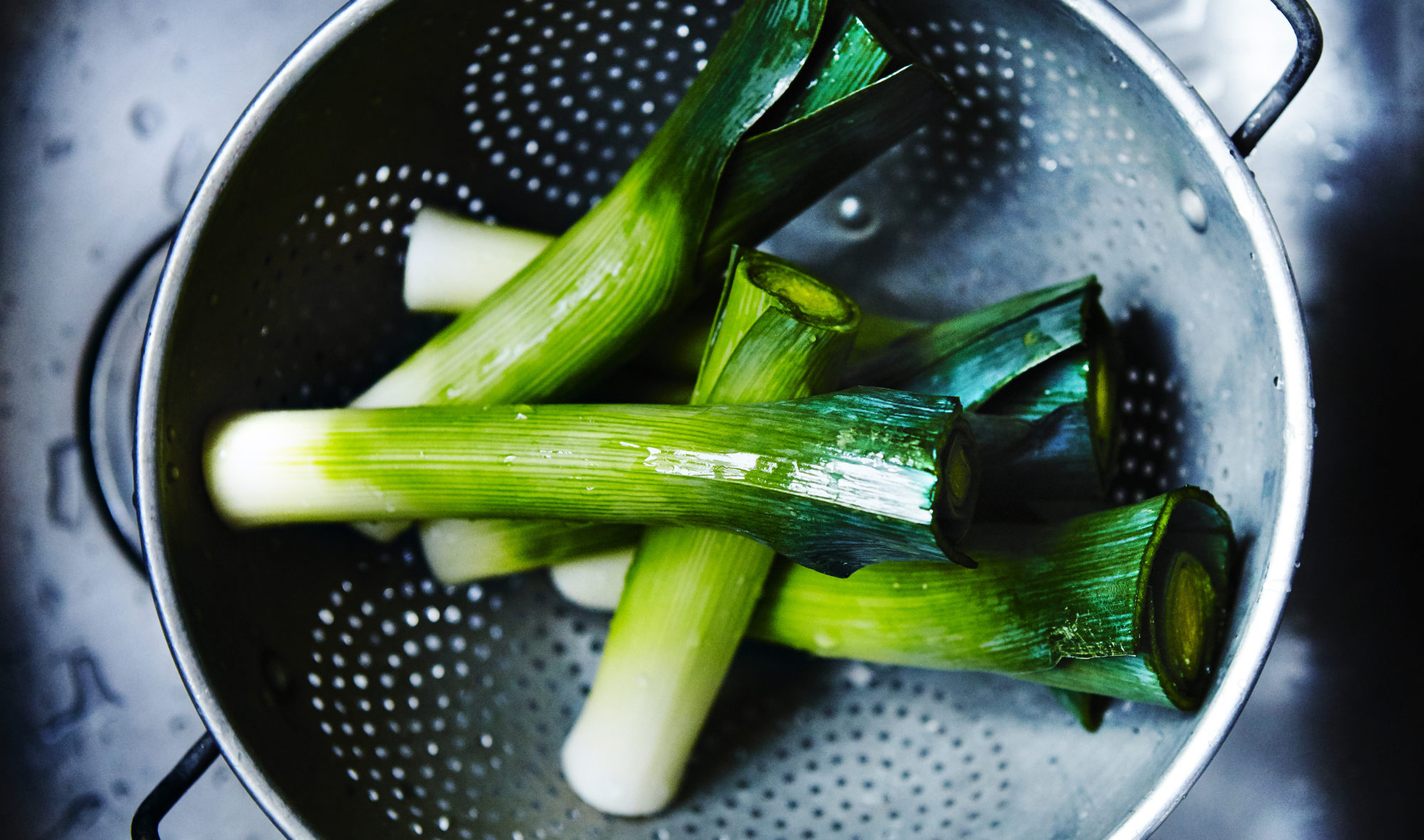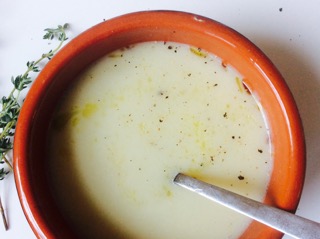
Leeks are a beautiful and nutritious member of the onion family. With their sweet, mild taste, they can be eaten raw in salads or cooked in a variety of ways, adding depth and richness to soups, stews, and many other recipes. High in flavonoids and polyphenols, leeks promote cardiovascular health and protect us against oxidative damage.
The beautiful pale green and white leek is a member of the Allium, or onion family. It looks like a larger, paler scallion. The edible part of the plant is a sheath of leaves and the small bulb. Easy to grow from seeds, leeks taste sweet and mild. They are crunchy when raw, and become silky-soft when cooked. They add extraordinary depth and complexity to soups, stews, and other slow-cooked preparations.
Like other vegetables in the onion family, leeks are high in flavonoids, especially kaempferol. Flavonoids support cardiovascular health by protecting our blood vessels from damage. Leeks are also high in folate and in polyphenols, which offer additional support to our cardiovascular system and may also help protect against oxidative stress and cancers.
The ancient Greeks and Romans believed that eating leeks could soothe the throat and improve the voice. The Romans introduced the plant to the UK, where it flourished in the cool growing conditions. Soon the Welsh adopted it as their national emblem, and today leeks remain an important part of Welsh, Scottish, and English cuisine. They are also popular in France.
Leeks can be wild or cultivated. Cultivated leeks look like a larger, paler scallions. They have a very small white bulb and pale to darker green leaves rising seamlessly from it in a tight roll. They are usually an inch or two wide, and may be a foot long. They smell sweet and oniony.
Wild leeks, often called ramps, look quite similar except they are smaller. Their flavor is more intense and onion-like. You might find them in farmers’ markets when they are in season.
One cup of raw leeks contains 54 calories, 13g of carbohydrates, 1g of protein, 2g of dietary fiber, and no dietary fat.
Leeks are high in vitamin A (one cup offers 30% of your daily requirement), and they’re a good source of vitamin C, vitamin K, and vitamin B6, as well as the minerals iron and manganese.
With their high concentration of flavonoids and polyphenols, leeks, like other better-researched members of the onion family, offer substantial protection against oxidative stress and cancers as well as cardiovascular disease.
Look for firm, straight leeks with bright white bulbs and green leaves. The bulbs should not be cracked or shriveled. The leaves should not look yellow or wilted. Leeks that are overly large tend to be less tender, so with leeks, bigger is not necessarily better. Choose bulbs about an inch to an inch and a half wide rather than enormous ones. Look for a bunch that is consistent in size since this allows for more even cooking.
Store leeks unwashed and untrimmed in your refrigerator, loosely wrapped in plastic. They’ll keep this way for a week or two. If you have a cold room in winter, you can also keep leeks there, much as you might do with onions.
Cooked leeks are perishable and will only last a day or two in your fridge.
You can also keep leeks longer by blanching them in boiling water for two minutes and then placing in the freezer. They lose some of their fresh taste and their texture but they will store this way for about 3 months and can be useful in some preparations.
To prepare, cut off the darker green tops of the leek and peel away any tough leaves. Cut the bulb and leaf portion in half and fan the pieces out in a sieve. Leeks require careful washing because the tightly rolled leaves often harbor sand and grit.
Once you wash and dry your leeks, you can slice them in a variety of ways, depending on how you intend to use them.
As Allium plants, leeks are high in sulfur-containing polyphenols. These are released and combined when the vegetable is sliced. So to improve the health benefits of leeks, allow them to sit for a few minutes after cutting and before proceeding with your recipe.
To sautée leeks, simply slice as you wish. Add a bit of oil, butter, or a mixture of fat and stock, wine, or water to a pan and heat on medium until it is hot. Add the leeks, and stir. Cook until they reach your desired level of doneness, covering if you want them to soften.

This soup has a creamy texture and subtle yet tasty flavor. It is a great compliment to any meal.
Prep Time: 15 minutes Cook Time: 30 minutes Yield: 4-6 bowls of soup
In a heavy bottomed, medium sized pot, add the oil, leeks and garlic, along with the salt and thyme, and cook over medium heat until leeks soften, about 5 minutes.
Rinse the lentils in a fine mesh strainer and add them to the pot. Add the water or stock, and bring up to a slow simmer. Remove any scum from the surface using a small ladle or a spoon. Cook, partially covered, until lentils are soft, about 25 minutes.
Working in batches, blend the soup using an immersion or stand blender, until smooth and nicely pureed.
Garnish each bowl with fresh cracked pepper, sea salt and a drizzle of nice olive oil.
Store leftovers in fridge.
Enjoy!
Precision Nutrition’s Encyclopedia of Food expands every single month as we highlight new foods and showcase beautiful food photography. If you’d like to stay up to date, simply click this link. From there, we’ll send you a FREE copy of our recipe book. We’ll also let you know when new and delicious foods are added to the site.
Leeks are a beautiful and nutritious member of the onion family. With their sweet, mild taste, they can be eaten raw in salads or cooked in a variety of ways, adding depth and richness to soups, stews, and many other recipes. High in flavonoids and polyphenols, leeks promote cardiovascular health and protect us against oxidative damage.